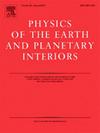On the deep carbon cycle in numerical modelling of mantle convection: Implications for the long-term climate evolution
IF 1.9
3区 地球科学
Q2 GEOCHEMISTRY & GEOPHYSICS
引用次数: 0
Abstract
A model of deep-water and carbon cycles was developed to elucidate the mechanisms governing the carbon cycle in Earth's deep interior. This model integrates the solubility limit of carbon in mantle rocks into numerical simulations of mantle convection. To account for the total carbon released from the deep interior, I considered both the carbon release flux through metamorphic decarbonization during subduction and the outgassing fluxes at mid-ocean ridges and hotspots. Additionally, the model assumes a carbon solubility of 1.0 wt% at the top of the mantle transition zone. The carbon budget within Earth's deep interior appears nearly balanced by the carbon uptake during subduction and the decarbonization of the subducting slab through metamorphic reactions. This study also suggests that a warmer climate is likely if the carbon release flux from the deep interior comprises both decarbonization and volcanic outgassing. Therefore, an Earth-like climate may be sustained by the carbon release associated with plate subductions. It is acknowledged that this study presents a case study of carbon cycle modelling in mantle convection simulations, with a specific emphasis on the integration of carbon solubility limits in mantle rocks based on the carbon solubility model in mantle minerals.

地幔对流数值模拟中的深层碳循环:对长期气候演化的影响
开发了一个深水和碳循环模型,以阐明控制地球深层内部碳循环的机制。该模型将地幔岩石中碳的溶解度极限与地幔对流数值模拟相结合。为了解释深海内部释放的总碳,我考虑了俯冲过程中变质脱碳的碳释放通量和大洋中脊和热点的放气通量。此外,该模型假定地幔过渡带顶部的碳溶解度为1.0 wt%。俯冲过程中的碳吸收和俯冲板块通过变质反应的脱碳作用使地球深部内部的碳收支趋于平衡。这项研究还表明,如果来自深层内部的碳释放通量包括脱碳和火山释放气体,那么气候变暖是可能的。因此,类似地球的气候可能是由与板块俯冲相关的碳释放来维持的。本研究为地幔对流模拟中的碳循环建模提供了一个案例研究,特别强调了在地幔矿物碳溶解度模型的基础上整合地幔岩石中的碳溶解度极限。
本文章由计算机程序翻译,如有差异,请以英文原文为准。
求助全文
约1分钟内获得全文
求助全文
来源期刊

Physics of the Earth and Planetary Interiors
地学天文-地球化学与地球物理
CiteScore
5.00
自引率
4.30%
发文量
78
审稿时长
18.5 weeks
期刊介绍:
Launched in 1968 to fill the need for an international journal in the field of planetary physics, geodesy and geophysics, Physics of the Earth and Planetary Interiors has now grown to become important reading matter for all geophysicists. It is the only journal to be entirely devoted to the physical and chemical processes of planetary interiors.
Original research papers, review articles, short communications and book reviews are all published on a regular basis; and from time to time special issues of the journal are devoted to the publication of the proceedings of symposia and congresses which the editors feel will be of particular interest to the reader.
 求助内容:
求助内容: 应助结果提醒方式:
应助结果提醒方式:


